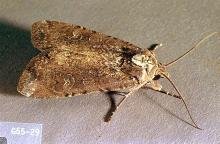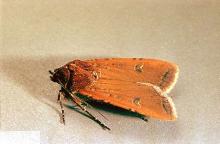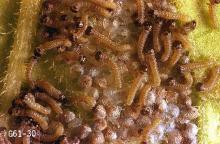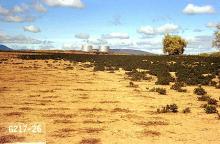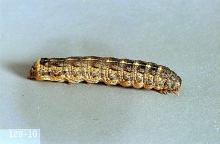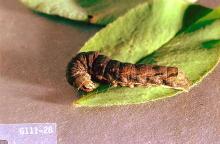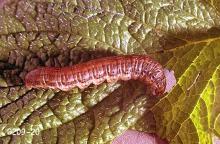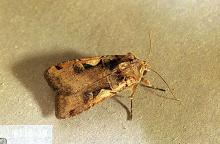Subterranean species include
Black cutworm (Agrotis ipsilon)
Glassy cutworm (Apamea devastator)
Redbacked cutworm (Euxoa ochrogaster)
Climbing species include
Army cutworm (Euxoa auxiliaris)
Spotted cutworm (Xestia c-nigrum)
Variegated cutworm (Peridroma saucia)
Pest description and crop damage Several species can cause significant damage to seedling-stage sugar beets, especially in fields where weedy spots or plant debris on the soil surface serve as sites for cutworm overwintering or early season egg laying. Cutworms generally are nocturnal, remaining by day just under the soil surface, so they are often not seen until after the plant already has been damaged.
Cutworm larvae are about 1 inch when mature and vary in color from light gray to dark brown, with faint stripes or fine mottles on their smooth, hairless, soft bodies. They curl into a motionless C-shape when disturbed.
Subterranean species feed on roots and stems, cutting off plants at the soil surface. Climbing species hide during the day in soil and either cut off plants at the soil surface or feed in the crown on newest leaves and stems.
Scouting and thresholds No formal economic thresholds exist for cutworm insecticide treatment decisions in sugar beets. Scouting at night and/or digging near damaged plants may be necessary to confirm presence of cutworms. Infestations typically are very spotty, usually occurring near weedy patches or along field borders. Consider spot treating infested sites rather than the entire field. Pheromone lures are available for some species that may be used to trap adults during autumn to predict risk of damage from larvae during the following spring.
Management-biological control
See Table 3 for commercially formulated biological products.
Management-chemical control
Numerous post-emergence insecticide options are available (Tables 2-3). Insecticide application during the evening may increase exposure of cutworms to insecticide during nighttime feeding. At-plant options are available as well (Table 1), but application decisions may have to be made before cutworm risk is known.


